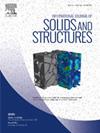The determination of interfacial strength in Al/SiC long fibre composites
IF 3.4
3区 工程技术
Q1 MECHANICS
International Journal of Solids and Structures
Pub Date : 2025-03-24
DOI:10.1016/j.ijsolstr.2025.113335
引用次数: 0
Abstract
The interfacial properties have been measured for a novel AA6061/SiC-C coated silicon carbide SM3256 monofilamentary fibre (Al/SiC) MMC using a variant of the single fibre fragmentation test. In this test, fibre fragmentation is followed in situ using synchrotron X-ray diffraction to probe the axial fibre elastic strains as a function of applied loading, while X-ray radiography is used to follow the fracture sequence. In this way, the variation in axial fibre stress along the fibre is tracked and hence the variation in interfacial shear stress along the fibre inferred at various stages of fibre fragmentation. Prior to loading, the fibre was in a state of axial compression (280 MPa) due to thermal residual stresses representative of cooling from 200 °C. During the fragmentation process, the variations in axial strain and interfacial stress show characteristic “stick–slip” behaviour, where the fibre interface must exceed a threshold stress ( = 94 ± 10 MPa), close to the shear strength of the matrix before debonding. Once debonded, the fibre slides at a frictional shear stress, , initially of around 40 MPa, but falling with increased sliding distance to around = 15 ± 5 MPa. Radiography taken during loading, and post-mortem, indicates that interfacial failure occurs at the fibre-coating interface, leaving coating material lining the pull-out within the matrix. The accumulation of coating damage may be responsible for the progressive decrease in sliding stress with increased sliding. These sliding stresses, are much lower than observed for comparable Ti/SiC composites, and would facilitate significant fibre-pull-out and fibre bridging under fatigue conditions.
Al/SiC长纤维复合材料界面强度的测定
采用不同的单纤维断裂测试方法,对新型AA6061/SiC-C涂层碳化硅SM3256单丝纤维(Al/SiCf) MMC的界面性能进行了测试。在本试验中,使用同步加速器x射线衍射原位跟踪纤维断裂,探测纤维轴向弹性应变作为施加载荷的函数,同时使用x射线照相跟踪断裂顺序。这样,沿纤维轴向应力的变化被跟踪,从而在纤维破碎的各个阶段推断沿纤维的界面剪切应力的变化。在加载之前,由于来自200°C冷却的热残余应力,纤维处于轴向压缩状态(≈280 MPa)。在破碎过程中,轴向应变和界面应力的变化表现出典型的“粘滑”行为,其中纤维界面必须超过阈值应力(τdeb = 94±10 MPa),接近基体的抗剪强度。一旦剥离,纤维在摩擦剪切应力τfr下滑动,最初约为40 MPa,但随着滑动距离的增加而下降,约为τfr = 15±5 MPa。加载过程中拍摄的x射线照片和事后分析显示,纤维涂层界面发生了界面破坏,导致涂层材料衬里在基体内被拉出。涂层损伤的累积可能是导致滑动应力随滑动量的增加而逐渐减小的原因。这些滑动应力远低于同类Ti/SiC复合材料,并将促进疲劳条件下显著的纤维拉出和纤维桥接。
本文章由计算机程序翻译,如有差异,请以英文原文为准。
求助全文
约1分钟内获得全文
求助全文
来源期刊
CiteScore
6.70
自引率
8.30%
发文量
405
审稿时长
70 days
期刊介绍:
The International Journal of Solids and Structures has as its objective the publication and dissemination of original research in Mechanics of Solids and Structures as a field of Applied Science and Engineering. It fosters thus the exchange of ideas among workers in different parts of the world and also among workers who emphasize different aspects of the foundations and applications of the field.
Standing as it does at the cross-roads of Materials Science, Life Sciences, Mathematics, Physics and Engineering Design, the Mechanics of Solids and Structures is experiencing considerable growth as a result of recent technological advances. The Journal, by providing an international medium of communication, is encouraging this growth and is encompassing all aspects of the field from the more classical problems of structural analysis to mechanics of solids continually interacting with other media and including fracture, flow, wave propagation, heat transfer, thermal effects in solids, optimum design methods, model analysis, structural topology and numerical techniques. Interest extends to both inorganic and organic solids and structures.

 求助内容:
求助内容: 应助结果提醒方式:
应助结果提醒方式:


